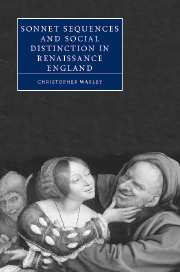Book contents
- Frontmatter
- Contents
- Preface
- 1 Sonnet sequences and social distinction
- 2 Post-romantic lyric: class and the critical apparatus of sonnet conventions
- 3 “An Englishe box”: Calvinism and commodities in Anne Lok's A Meditation of a Penitent Sinner
- 4 “Nobler desires” and Sidney's Astrophil and Stella
- 5 “So plenty makes me poore”: Ireland, capitalism, and class in Spenser's Amoretti and Epithalamion
- 6 “Till my bad angel fire my good one out”: engendering economic expertise in Shakespeare's Sonnets
- 7 “The English straine”: absolutism, class, and Drayton's Ideas, 1594–1619
- Afterword: Engendering class: Drayton, Wroth, Milton, and the genesis of the public sphere
- Notes
- Index
- Cambridge Studies in Renaissance Literature and Culture
2 - Post-romantic lyric: class and the critical apparatus of sonnet conventions
Published online by Cambridge University Press: 22 September 2009
- Frontmatter
- Contents
- Preface
- 1 Sonnet sequences and social distinction
- 2 Post-romantic lyric: class and the critical apparatus of sonnet conventions
- 3 “An Englishe box”: Calvinism and commodities in Anne Lok's A Meditation of a Penitent Sinner
- 4 “Nobler desires” and Sidney's Astrophil and Stella
- 5 “So plenty makes me poore”: Ireland, capitalism, and class in Spenser's Amoretti and Epithalamion
- 6 “Till my bad angel fire my good one out”: engendering economic expertise in Shakespeare's Sonnets
- 7 “The English straine”: absolutism, class, and Drayton's Ideas, 1594–1619
- Afterword: Engendering class: Drayton, Wroth, Milton, and the genesis of the public sphere
- Notes
- Index
- Cambridge Studies in Renaissance Literature and Culture
Summary
All translations into languages that are the heirs and depositaries of Western metaphysics thus produce on the pharmakon an effect of analysis that violently destroys it, reduces it to one of its simple elements by interpreting it, paradoxically enough, in the light of the ulterior developments it itself has made possible.
[A]ll isolated or discrete cultural analysis always involves a buried or repressed theory of historical periodization.
Any historical study of Renaissance sonnet sequences must begin in the nineteenth century. Though obviously neither sonnets nor sonnet sequences were literally invented in the nineteenth century, the extensive, explicit, theoretical scrutiny of them begun with the Romantics has fundamentally shaped understandings of both sequences and the Renaissance ever since. The term “sonnet sequence” was thought up by Dante Gabriel Rossetti in 1880, and at least sixteen sonnet anthologies, dozens of articles and essays, and over two hundred and sixty sonnet sequences appeared through the century. The renewed interest in the sonnet eventually resulted in the critical apparatus still ordinarily used today to describe sonnet sequences: the familiar vocabulary of sonnet “conventions,” of Petrarchism and its attendant ideology. This critical apparatus has become so pervasive as to seem self-evident; what could possibly be more obvious than Petrarchan cliches? As the concise introduction to Sidney's Astrophil and Stella in the seventh edition Norton Anthology of English Literature puts it,
[Sidney used] well established conventions, borrowed from Petrarch and his many Italian, French, and Spanish imitators. These conventions bequeathed a loose framework of plot, marking the stages of a love relationship from its starting point in the lover's attraction to the lady's beauty through various trials, sufferings, conflicts, and occasional encouragements to a conclusion in which nothing is resolved.
- Type
- Chapter
- Information
- Publisher: Cambridge University PressPrint publication year: 2005



